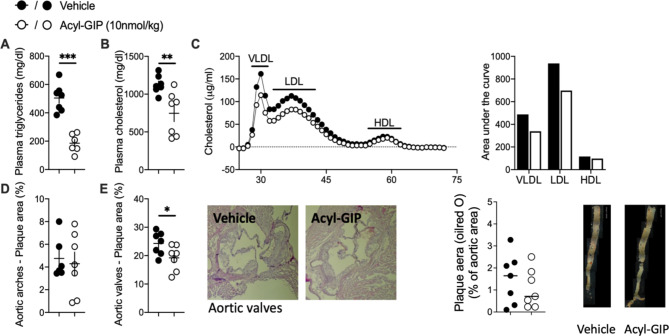Correction to: Cardiovasc Diabetol (2023) 22:217
10.1186/s12933-023-01940-2
Following publication of the original article [1], the author noticed the errors in Fig. 2 and in Results section.
Fig. 2.
Acyl-GIP ameliorates dyslipidemia and atherosclerotic plaque formation in LDLR-/- male mice. Plasma (A) triglycerides, (B) cholesterol and (C) lipoprotein fractions as well as (D and E) the percentage of plaque area in aortic arches and valves and along the descending aorta of male LDLR-/- mice treated daily with either vehicle or acyl-GIP via subcutaneous injections for 28 days. n = 7. Blood lipids were determined from sac plasma at the end of the study. Data represent means ± SEM. *P < 0.05, **P < 0.01, *** P < 0.001, determined by unpaired two-sided t-test
The bar graph is mistakenly duplicated in “percentage of plaque area of the aortic valves” of Fig. 2E. The corrected figure is given below:
In Result section under the heading “GIPR-agonist acyl-GIP ameliorates dyslipidemia and atherosclerotic plaque formation in male LDLR-/- mice independently of weight loss”, the last sentence should read “Most importantly, acyl-GIP treatment was accompanied by reduced atherosclerotic plaque formation within the aortic valve and a trend to decrease fat streaks along the descending aorta (Fig. 2E)“ instead of “Most importantly, acyl-GIP treatment was accompanied by reduced atherosclerotic plaque formation within the aortic valve (Fig. 2G–H) and decreased fat streaks along the descending aorta (Fig. 2I)”.
Footnotes
Publisher’s note
Springer Nature remains neutral with regard to jurisdictional claims in published maps and institutional affiliations.
Stephan Sachs and Anna Götz contributed equally.
Contributor Information
Timo D. Müller, Email: timodirk.muller@helmholtz-munich.de
Susanna M. Hofmann, Email: susanna.hofmann@helmholtz-munich.de
Reference
- 1.Sachs S, Götz A, Finan B, et al. GIP receptor agonism improves dyslipidemia and atherosclerosis independently of body weight loss in preclinical mouse model for cardio-metabolic disease. Cardiovasc Diabetol. 2023;22:217.10.1186/s12933-023-01940-2 10.1186/s12933-023-01940-2 [DOI] [PMC free article] [PubMed] [Google Scholar]



